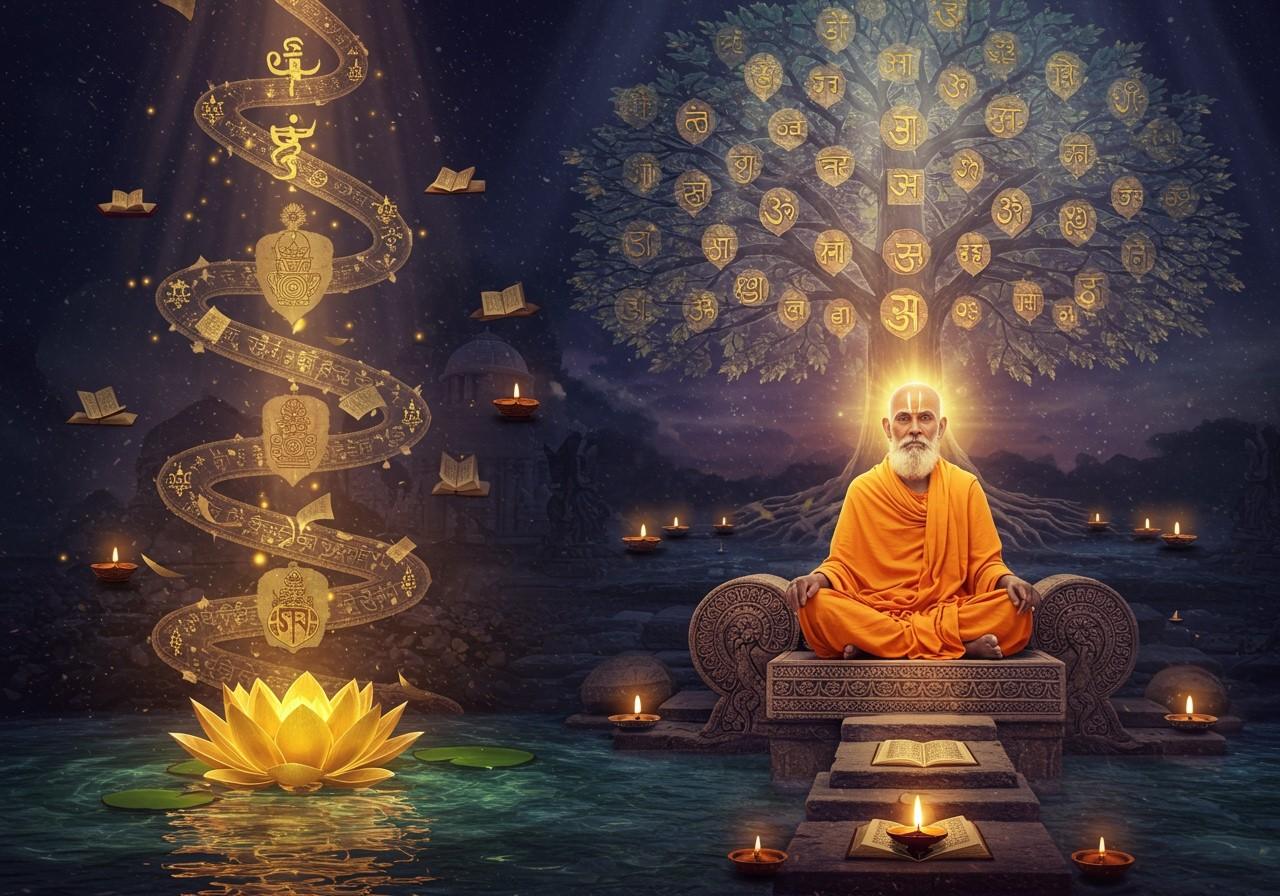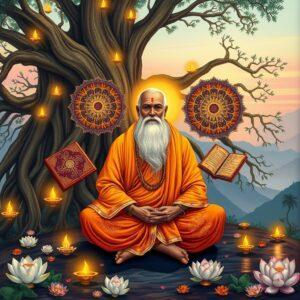
The Upanishads, ancient Indian texts, serve as the philosophical bedrock of Hinduism. They delve into the nature of reality and the self, exploring the profound connection between Atman (the individual self) and Brahman (the ultimate reality). These texts guide individuals towards self-realization and spiritual enlightenment, challenging conventional notions of the self and the universe. The Upanishads remain highly influential in modern spirituality, inspiring seekers to explore their inner selves and cultivate a deeper understanding of existence. Written between 800 BCE and 500 BCE, they are considered the concluding part of the Vedas, often referred to as Vedanta.
Understanding the Upanishads
The term ‘Upanishad’ translates to ‘sitting down near,’ reflecting the tradition of disciples gathering near their guru to receive wisdom. These Sanskrit texts comprise dialogues, narratives, and philosophical discussions, primarily focusing on metaphysical inquiries. They explore the nature of ultimate reality (Brahman) and the individual soul (Atman), seeking to understand the fundamental principles of existence.
The Ten Principal Upanishads
Within Hindu philosophy, the Principal Upanishads hold a position of reverence due to their profound teachings. These ten texts are particularly significant:
- Isha Upanishad
- Kena Upanishad
- Katha Upanishad
- Prashna Upanishad
- Mundaka Upanishad
- Mandukya Upanishad
- Taittiriya Upanishad
- Aitareya Upanishad
- Chandogya Upanishad
- Brihadaranyaka Upanishad
Each text offers unique perspectives on philosophy, spirituality, and ethics, contributing to a comprehensive understanding of Hindu thought.
Delving into the Principal Upanishads
Isha Upanishad
Found within the Shukla Yajurveda, the Isha Upanishad emphasizes the unity of the self with the universe. The verse ‘Ishavasyam idam sarvam’ (All this is pervaded by God) encapsulates the core message, encouraging a life lived with the awareness of divine presence permeating all things. This Upanishad promotes a life of active engagement with the world while maintaining a sense of detachment.
Kena Upanishad
Associated with the Sama Veda, the Kena Upanishad explores the nature of Brahman and the inherent limitations of human perception. It poses thought-provoking questions such as ‘By whom is the mind directed?’ and ‘By whom is speech propelled?’ These inquiries encourage deep contemplation on the nature of consciousness and the ultimate source of knowledge.
Katha Upanishad
Belonging to the Krishna Yajurveda, the Katha Upanishad unfolds the story of Nachiketa’s encounter with Yama, the god of death. This narrative serves as a framework for exploring the nature of the soul, the cycle of death and rebirth (samsara), and the path to spiritual liberation (moksha). The Upanishad provides valuable insights into navigating life’s challenges and seeking ultimate truth.
Prashna Upanishad
Part of the Atharva Veda, this Upanishad features a series of questions posed by disciples to the sage Pippalada. These questions delve into fundamental aspects of existence, such as the origin of the universe, the nature of vital forces (Prana), and the role of meditation in spiritual development. The Prashna Upanishad offers practical guidance for seekers on their spiritual path.
Mundaka Upanishad
Also from the Atharva Veda, the Mundaka Upanishad distinguishes between higher knowledge (Paravidya) and lower knowledge (Aparavidya). It emphasizes the importance of direct experience and meditation as pathways to realizing Brahman. This Upanishad encourages seekers to move beyond intellectual understanding and cultivate direct realization of truth.
Mandukya Upanishad
The shortest of the Upanishads, also part of the Atharva Veda, the Mandukya Upanishad discusses the four states of consciousness: waking, dreaming, deep sleep, and the transcendental fourth state, Turiya. It also explores the significance of the sacred syllable ‘AUM’ as the essence of all existence. This concise yet powerful text offers a deep understanding of consciousness and its connection to ultimate reality.
Taittiriya Upanishad
Found within the Yajurveda, the Taittiriya Upanishad comprises three sections: Siksha Valli, Brahmananda Valli, and Bhrigu Valli. It covers ethical teachings, the nature of joy (ananda), and the five layers of human existence (Koshas). This Upanishad provides a holistic approach to spiritual development, encompassing ethical conduct, the pursuit of joy, and understanding the multifaceted nature of the self.
Aitareya Upanishad
Part of the Rigveda, the Aitareya Upanishad focuses on the creation of the universe and the nature of the soul (Atman). It identifies Atman as the ultimate reality and the source of all life. This Upanishad explores the interconnectedness of all beings and the fundamental unity underlying the diversity of the universe.
Chandogya Upanishad
Associated with the Sama Veda, the Chandogya Upanishad is a comprehensive text covering various themes, including the importance of Om, the nature of Brahman, and the practice of meditation. It contains the renowned Mahavakya ‘Tat Tvam Asi’ (Thou art That), emphasizing the oneness of the individual soul with Brahman. This Upanishad provides a rich tapestry of spiritual teachings, guiding seekers towards self-realization.
Brihadaranyaka Upanishad
One of the oldest and most extensive Upanishads, found in the Yajurveda, the Brihadaranyaka Upanishad offers in-depth discussions on the nature of reality, the self, and the universe. It employs the concept of ‘Neti Neti’ (Not this, Not this) to describe Brahman, highlighting the limitations of language and thought in grasping the ultimate reality. This Upanishad challenges conventional understanding and encourages seekers to transcend limitations in their pursuit of truth.
Poojn.in: Supporting Your Spiritual Journey
Poojn.in, India’s leading online store for cultural and spiritual goods, offers a wide selection of products to enhance your exploration of the Upanishads and Hindu philosophy. Discover:
- Sacred malas: Enhance your meditation practice with genuine Tulsi and Rudraksha malas, crafted with traditional methods and imbued with spiritual significance. These malas aid in focusing the mind during japa and meditation, deepening your connection with the divine. Available in various sizes and styles to suit your preferences.
- Idols and Murtis: Bring the divine presence into your home with beautifully crafted idols of deities associated with the Upanishads. Poojn.in offers a wide selection of murtis made from pure brass, copper, and other sacred materials. These idols serve as focal points for devotion and contemplation, enriching your spiritual practice.
- Incense and Samagri: Create a serene atmosphere for study and reflection with high-quality incense, dhoop, and other puja samagri. Poojn.in offers a wide variety of traditional fragrances to enhance your spiritual practice, including sandalwood, agarwood, and more.
Conclusion
The Principal Upanishads offer invaluable insights into the depths of Hindu philosophy. By studying these texts, you can gain a profound understanding of the nature of reality, the self, and the universe. Each Upanishad provides unique teachings that can guide and enrich your spiritual journey. Embrace the wisdom of these ancient texts to connect with the timeless truths they reveal.


